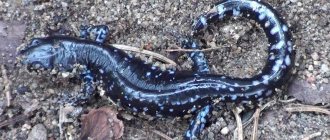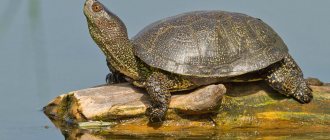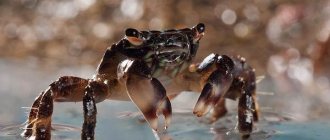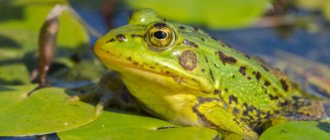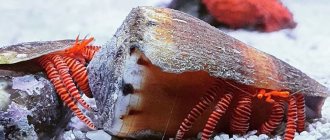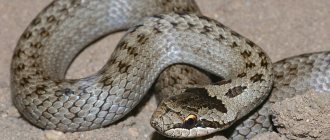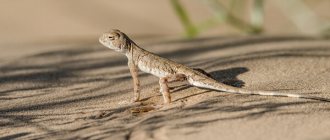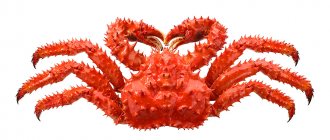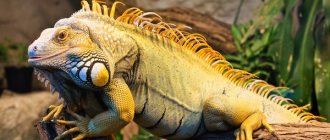- Wild animals
- >>
- Amphibians
The salamander is an amphibian, which in ancient times people were very afraid of, they composed legends about it, revered it, and also attributed magical abilities. This was due to the appearance of the salamander and its behavior. For a long time, people believed that animals do not burn in fire because they themselves are made of fire. Indeed, translated from the language of the ancient Persians, salamander means “burning from the inside.”
Origin of the species and description
Photo: Salamander
In their appearance, salamanders strongly resemble lizards, but zoologists classify them into different classes: lizards into the reptile class, and salamanders into the amphibian class, the genus salamander.
In the process of evolution, which lasted millions of years, all representatives of the genus were divided into three main groups:
- real salamanders (Salamandridae);
- lungless salamanders (Plethodontidae);
- cryptobranch salamanders (Cryptobranchidae).
The differences between all three groups are in the respiratory system, which is structured completely differently. For example, the first breathe with the help of lungs, the second with the help of mucous membranes and skin, and the third with the help of hidden gills.
Video: Salamander
The body of salamanders is elongated, smoothly turning into a tail. Amphibians range in size from 5 to 180 cm. The skin of salamanders is smooth to the touch and always moist. Their color range is very diverse depending on the species and habitat: yellow, black, red, olive, green, purple. The back and sides of animals can be covered with large and small spots, stripes of various colors.
Interesting fact: The smallest salamanders in the world are the dwarf Eurycea quadridigitat with a body length of up to 89 mm, and the very tiny Desmognathus wrighti with a body length of up to 50 mm. And the world's largest salamander, Andrias davidianus, living in China, reaches a length of up to 180 cm.
Salamanders have short and stocky legs. The front limbs have 4 fingers, and the hind limbs have 5. There are no claws on the fingers. The head is flattened, similar to the head of a frog, with bulging and, as a rule, dark eyes with movable eyelids.
In the skin of animals there are special glands (mumps) that produce poison. The venom of salamanders is usually not fatal, but if you try to eat it, it can paralyze the predator for some time and also cause convulsions in it. Salamanders live almost everywhere where the climate is warm and humid, but the greatest diversity of species can be found in North America.
How to choose quality equipment
When choosing this equipment, attention is first paid to the type of grill. If the kitchen is cramped, a model with an infrared heating element is suitable - the air around the device will not be hot. For a spacious stationary kitchen, a grill equipped with heating elements is suitable. Models with gas burners are the best option for street trading and fast food outlets
It is easier to move such a grill from one place to another, because it does not depend on power supply and, in some way, is mobile equipment. Models with a movable top part will be more economical in consuming electricity or gas due to heat retention, but the price of grills with this design is always higher. Dimensions are selected depending on the installation location. This could be a table, a bar counter, or a food distribution line. The grill can be easily mounted on the wall in the kitchen. For example, near the stove. It can also be installed outside the kitchen, placed in the room where food is prepared by waiters for serving in the dining room. This will make it possible for the heated food to be immediately taken out to restaurant or cafe visitors.
Appearance and features
Photo: What a salamander looks like
All salamanders are very similar to each other in appearance: they have an elongated body with smooth slimy skin, a rather long tail, not very developed limbs without claws, a small head with bulging black eyes and movable eyelids, allowing you to examine the surroundings without turning your head. The jaws of amphibians are poorly developed, since they are not at all adapted to eating hard food. Because of their clumsiness, animals feel much more comfortable in water than on land.
Salamanders, unlike their closest relatives - lizards, are also very interesting with their variety of colors in literally all the colors of the rainbow. As usual in nature, behind the bright and spectacular appearance lies a danger - a poison that can burn and even kill. All species of salamanders are poisonous to one degree or another, but only one species of these animals has deadly poison - the Fire Salamander.
In myths and legends composed in ancient times, the salamander has always been assigned the role of a servant of dark forces. This prejudice existed partly because of the unusual appearance, but also because of the ability, in case of danger, to produce a poisonous secretion from the skin, which could both cause a severe burn to the skin (in humans) and paralyze or even kill (smaller animals).
Now you know whether the salamanda is poisonous or not. Let's see where this amphibian lives.
Area
This species of amphibian lives mainly in Europe. Here he lives everywhere except Great Britain and Scandinavia. Outside of Europe, the fire salamander can be found in Turkey and Iran.
Despite the fact that the salamander animal is an amphibian, in its adult stage it lives near water, but still on land. Favorite habitats are thickets of broad-leaved and mixed forests on the banks of rivers, streams and lakes.
Preference is given to areas where a thick layer of forest litter with a predominance of fallen leaves remains. Particularly valuable as a habitat for salamanders are areas where various mosses are common. Moss cushions usually maintain high humidity, and invertebrate animals also hide in them.
We recommend reading: Do cats need water treatments: opinions and advice from veterinarians
Where does the salamander live?
Photo: Salamander in Russia
The habitat of salamanders is quite extensive. To summarize, they live almost everywhere, on all continents, where there is a warm, mild and humid climate without sharp changes in seasonal, day and night temperatures. However, most species can be seen in North America.
Alpine salamanders, of course, live in the Alps (eastern and central parts of the mountains), and they can be found at altitudes of up to 1000 m above sea level. Salamanders are also quite common in Switzerland, Austria, Italy, Slovenia, Croatia, Bosnia, Serbia, Montenegro, Herzegovina, southern France, Germany and Liechtenstein.
There are species that live in a very limited area. For example, the Lanza salamander lives exclusively in the western part of the Alps, literally on the border of Italy and France, in the Chisone valley (Italy), in the valleys of the Po, Gil, Germanasca, and Pellice rivers.
Many species of a wide variety of salamanders are found in Western Asia and throughout the Middle Eastern region - from Iran to Turkey.
Interesting fact: The Carpathians are home to one of the most poisonous salamanders - the alpine black salamander. Animal venom, released through the skin through special glands, causes very severe burns on the skin and mucous membranes, which do not heal for a very long time.
Prehistoric animals living near us (video)
The name of the species is Chinese giant salamander, which fully corresponds to the size of the individuals. This species is considered relict and, of course, endangered. It is listed in the Red Book. However, its well-being depends not only on how protected the individuals are, but also on the preservation of China's moist mountain forests. Despite its unusual appearance, the animal is harmless. It has no poison and feeds on small fish, amphibians and invertebrates that live in the water.
Among the representatives of the family of true salamanders, there are many species that have strong poison. The described venom of fire salamanders is classified as a moderate toxin. The Alpine black newt has the most powerful poison. It also lives in deep forests, where high levels of humidity are constantly maintained.
All salamanders represent a wide variety of adaptations to environmental conditions. Moreover, the process of evolutionary development in this category of animals proceeds at a surprisingly fast pace.
What does a salamander eat?
Photo: Black salamander
What salamanders eat depends mainly on their habitat. For example, small amphibians living on land hunt flies, mosquitoes, butterflies, spiders, cicadas, earthworms, and slugs. Larger salamanders prefer to hunt small lizards, newts, and frogs. Animals living in reservoirs catch crustaceans, mollusks, small fish, and fry.
When climatic conditions permit, amphibians can hunt all year round. The period of greatest activity of salamanders occurs at night. In the dark, they come out of their hiding places to walk and hunt, and they can do this from the evening until dawn.
To catch their prey, they first watch it for a long, long time without moving, thanks to their bulging eyes and moving eyelids. Salamanders catch prey by throwing out their long, sticky tongue. If the animal manages to get closer to the prey unnoticed, then it will probably not be able to escape.
Having caught their prey with a sharp movement, they lean on it with their whole body and try to swallow it whole without chewing. After all, the salamander’s jaws and mouth are not at all suited for chewing. With small animals (insects, slugs) everything turns out simply, with larger prey (lizards, frogs) the animal has to really try. But then the salamander feels full for several days.
Diet of the Nile crocodile
The diet of the Nile crocodile undergoes dramatic changes throughout the life of this reptile. The cubs, which do not grow to 1 meter, mainly feed on insects and other small invertebrates. Of these, about half are various beetles, which small crocodiles especially like to eat. At night, the cubs can also hunt crickets and dragonflies, which they catch in the thick grass on the banks of ponds.
After the growing reptile reaches a size of one and a half meters, it begins to hunt crabs and snails, but as soon as it grows to 2 meters in length, the number of invertebrates in its menu is greatly reduced. And only in Uganda alone, even fully grown crocodiles rarely, but still eat large snails and a variety of freshwater crabs.
Fish appears in the diet of a young Nile crocodile after it grows to at least 1.2 meters, but at the same time it continues to feed on invertebrates: large insects, crabs and mollusks like snails.
At the same time, the reptile tries to hunt fish that match its size. A large crocodile will not chase small fish in the river, and, first of all, this is due to the fact that they are much more mobile than, for example, quite large catfish, which the rather large Nile crocodile prefers to feed on.
But it would be wrong to think that Nile crocodiles eat tens of kilograms of fish at a time: reptiles, characterized by low mobility, require significantly less food than warm-blooded animals, and therefore, a reptile weighing less than 120 kg, on average, eats only 300 grams of fish. Due to the fact that there are a lot of crocodiles in African rivers, there is a natural regulation of the number of fish species living in the same lakes, rivers and other bodies of water as these reptiles, but no significant damage is caused to their population.
Crocodiles can also prey on amphibians and other reptile species. At the same time, adult frogs do not eat, although growing young animals feed on them with pleasure. And among reptiles, Nile crocodiles even eat poisonous snakes, such as the black mamba. Turtles and some particularly large lizards, such as the Nile monitor, are also eaten by adult animals. Young crocodiles also try to hunt turtles, but due to the fact that until a certain age they do not have enough strength to bite through a turtle shell, such a hunt could hardly be called successful.
But birds are rare on the crocodile menu and, in general, make up only 10-15% of the total amount of food eaten by the reptile. Most birds become victims of crocodiles by accident, as, for example, happens with fledgling cormorant chicks that accidentally fall from the nest into the water.
Large adult individuals, whose size exceeds 3.5 meters, prefer to hunt mammals, mainly ungulates, which come to a river or lake to drink. But even young animals that have reached a length of 1.5 meters can already begin to hunt mammals that are not too large in size, such as small monkeys, small species of antelope, rodents, lagomorphs and bats. Their menu even includes such exotic things as pangolins, also called pangolins, but not related to reptiles. Small predators such as mongooses, civets and servals can also become victims of a growing crocodile.
Adult crocodiles prefer to hunt larger game, such as kudu, wildebeest, eland, zebra, buffalo, giraffe, forest pigs, and especially large specimens can even hunt rhinoceroses and young elephants. They even hunt such dangerous predators as lions, leopards and cheetahs. Quite often, the reptile’s diet is replenished with the meat of hyenas and hyena dogs, which also become their victims near watering places.
Nile crocodiles have also been observed eating livestock and people. If you believe the statements of the inhabitants of African villages, then several people are necessarily dragged away and eaten by crocodiles once a year. To conclude the topic regarding the diet of reptiles of this species, we can also add that Nile crocodiles were also observed in cannibalism, when adults ate the eggs of their relatives or cubs of their own species, in addition, this reptile is quite capable of eating an opponent killed in battle.
Features of character and lifestyle
Photo: Orange salamander
Salamanders move rather slowly, and in general they generally move very little, but mostly sit in one place, lazily examining their surroundings. Animals are most active at night, and during the day they try to hide in abandoned holes, old stumps, in thick grass, in piles of rotten brushwood, avoiding direct sunlight.
Salamanders also hunt and breed at night. There must be at least some kind of body of water near their habitat. After all, salamanders cannot live without water, and all because their skin quickly dehydrates.
If salamanders do not live in the tropics, then their wintering season begins in mid-autumn, which, depending on the region where they live, can last almost until mid-spring. At this time, their home is deep abandoned holes or large piles of fallen leaves. Salamanders can winter either alone, which is more typical for them, or in groups of several dozen individuals.
In the wild, salamanders have many enemies, so in order to escape, the animals secrete a poisonous secretion that paralyzes the jaws of predators. If this does not help, they may even leave their limbs or tail in their teeth or claws, which will grow back after a while.
Keeping a lizard at home
Some exotic lovers choose a salamander as a pet. Keeping a lizard at home is not difficult, however, it requires attention to the following details.
- Lizards do not tolerate heat and direct sunlight well, so you need to make sure that the place for the terrarium is not in the sun. Place the terrarium in the shade and use fluorescent lamps for lighting.
- The humidity inside the terrarium should not be below 75%.
- Line the bottom of the “house” with a mixture of soil, peat, charcoal, stones, and fresh moss. Lizards love to burrow into fresh, soft moss, so the moss in the terrarium should be updated whenever possible.
- The ideal terrarium for a pet salamander contains driftwood, rocks and live planted plants.
- You should not keep two males in the same room; this can lead to constant conflicts between them. The best keeping option would be a male and two females or a pair: a male and a female.
- Be sure to build an artificial pond for your pet - lizards love to swim, take water treatments and just be in the water. The water needs to be changed every two days, or more often.
- Freshwater pets have a good appetite, however, you should not overfeed them. The salamander should be given food no more than twice a day.
- It is not recommended to handle the animal, since the skin of freshwater animals contains a special poisonous secretion.
- The diet of such a pet must include small live insects (men, snails, worms), as well as pieces of liver, meat and fish.
Social structure and reproduction
Photo: Salamander eggs
On average, salamanders can live up to 20 years, but their life expectancy depends on the specific species and habitat. Small species of these animals become sexually mature at 3 years, and large ones later - at 5 years.
Cryptobranch salamanders lay eggs, and true salamanders can be either viviparous or ovoviviparous. Amphibians can reproduce throughout the year, but the peak of mating activity occurs in the spring months.
When a male salamander is ready to mate, a special gland swells and is filled with spermatophore—male reproductive cells. He is very excited and the main goal of his life at this moment is to find a female and fulfill the duty of procreation. If there are several contenders for the female’s attention, then the males may fight.
Males release the spermatophore directly onto the ground, and females absorb it through the cloaca. In water, the fertilization process occurs differently: females lay eggs, and males water them with spermatophore.
Fertilized eggs attach to algae stems or roots. In viviparous species, larvae develop inside the womb within 10-12 months. In aquatic salamanders, the young hatch from eggs after about 2 months with fully formed gills. In appearance, the larvae are somewhat reminiscent of tadpoles.
Interesting fact: In viviparous salamanders, out of 30-60 fertilized eggs, only 2-3 babies are born, and the remaining eggs are just food for future offspring.
Salamander larvae live and feed in water for about three months, gradually transforming and acquiring the appearance of adults. Before the completion of metamorphosis, small salamanders crawl a lot along the bottom of reservoirs and often emerge, trying to breathe air. Young individuals have no connections with their parents and upon completion of metamorphosis they begin their independent life.
Natural enemies of salamanders
Photo: Salamander in nature
In nature, salamanders, due to their slowness and peculiar variegated bright colors, have many enemies, since they are very easy to notice. The most dangerous of them are snakes, as well as larger poisonous and non-venomous snakes.
It is also better for them not to catch the eye of large birds - falcons, hawks, eagles, owls. Birds usually do not swallow amphibians alive - this is fraught, as you can get a decent portion of poison. Usually the birds grab the salamanders with their claws and kill them by throwing them from a height onto the stones, and only then start eating, unless, of course, no one has stolen the prey, which happens quite often.
Wild boars, martens and foxes are also not averse to feasting on salamanders. Moreover, it is wild boars who manage to hunt them with great success, since these animals have a fairly large mouth, which allows them to quickly swallow the prey before it has time to come to its senses and secrete poison from the skin. Foxes and martens have a much more difficult time in this regard - the prey may have time to paralyze their jaws with poison or escape completely, leaving a paw or tail in its teeth.
In the aquatic environment, salamanders also have many enemies. Any large predatory fish - catfish, perch or pike - can dine on animals, but more often their larvae. Smaller fish are not averse to eating eggs.
Population and species status
Photo: What a salamander looks like
Due to their variability, diversity and vast habitat, zoologists have identified many species and subspecies of salamanders. Previously, seven main species of salamanders were identified, but recent biochemical studies of genetic material have shown that there are only four.
Main types of salamanders:
- Maghreb salamander (Salamandra algira Bedriaga), found and described in 1883 in Africa;
- Corsican salamander (Salamandra corsica Savi), described in 1838 on the island of Corsica;
- the Central Asian salamander (Salamandra infraimmaculata Martens), described in 1885 in Western Asia and having 3 subspecies (with 3 subspecies);
- spotted salamander (Salamandra salamandra) described in 1758, living in Europe and the European part of the former USSR, having 12 subspecies.
Of all the known subspecies, the Fire Salamander is the most studied.
The venom of most species of salamanders is considered not fatal to humans, but at the same time very dangerous, since it can cause severe burns if it comes into contact with the skin. For this reason, holding salamanders in your hand is highly undesirable. In general, salamanders are not very dangerous animals. After all, they never attack people themselves, since they have neither sharp claws nor teeth for this.
